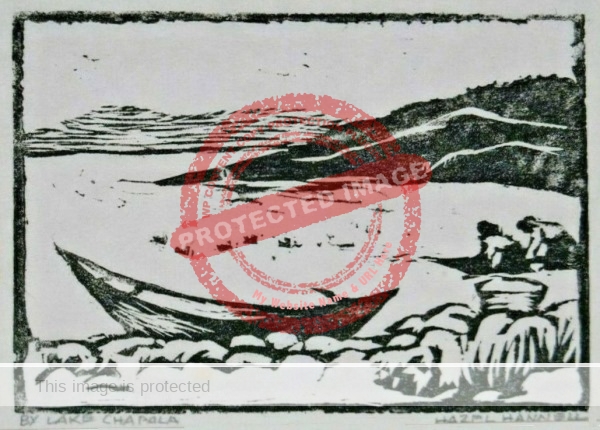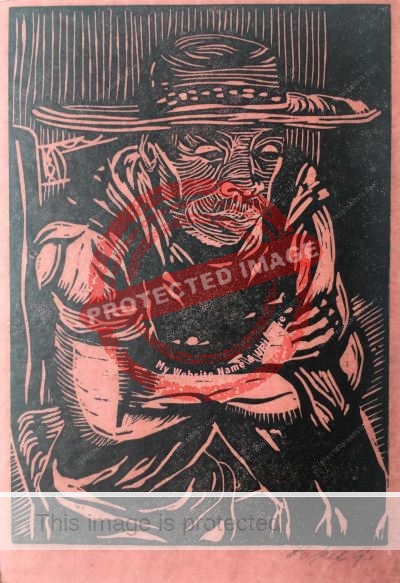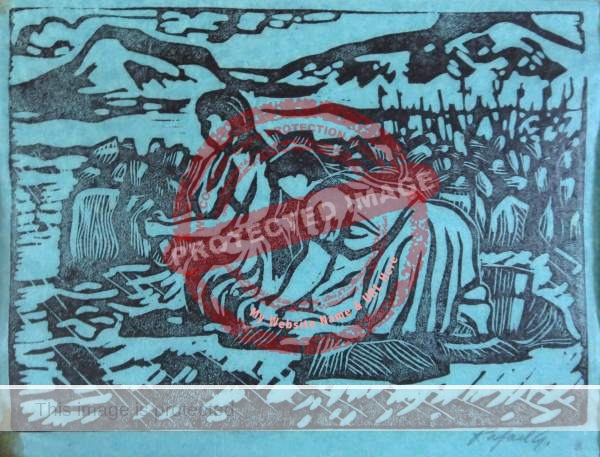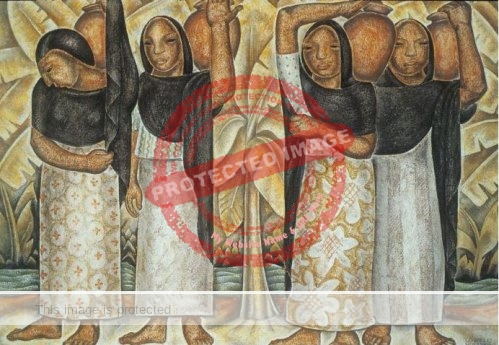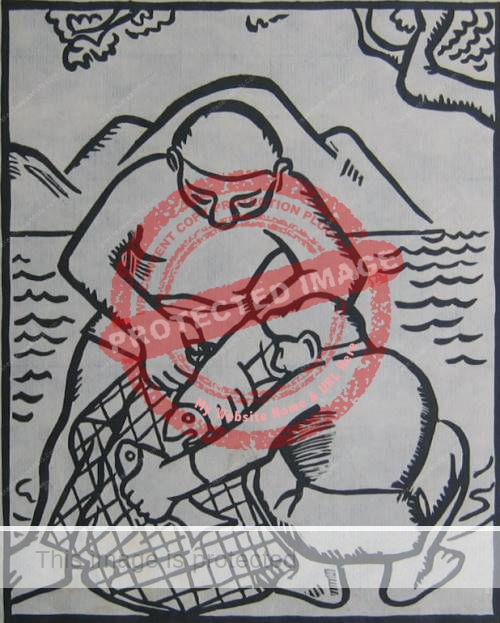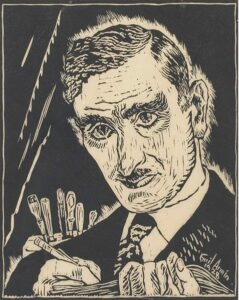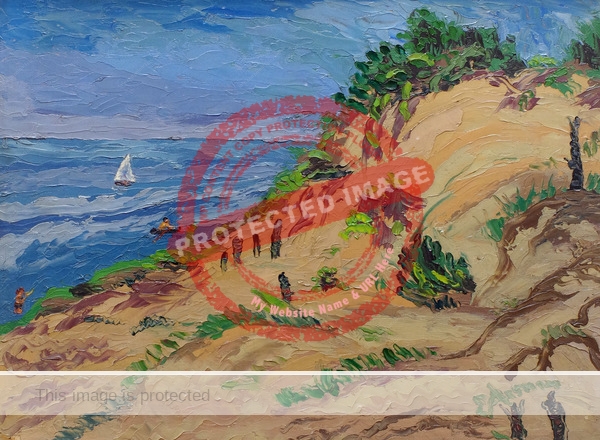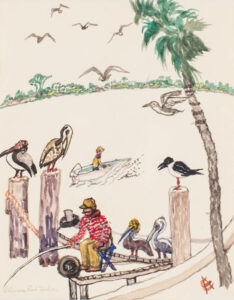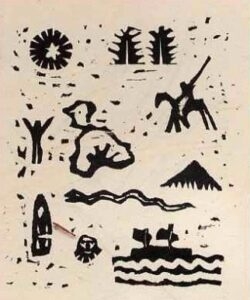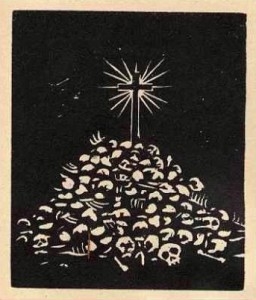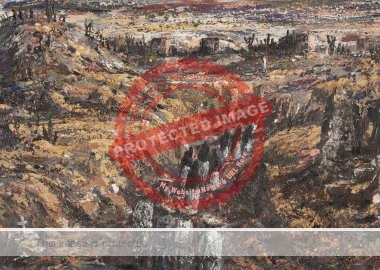Lowell D. Houser (1902-1971) lived and painted in Chapala, and later Ajijic, in the mid-1920s. He was subsequently hired to paint copies of Mayan murals for an archaeological survey of the Yucatán Peninsula.
Houser was born in Chicago on 18 May 1902. During his childhood, the family moved to Iowa, where Houser graduated from Ames High School in 1921. He then studied briefly at Iowa State University before switching to the Art Institute of Chicago. During his three years in Chicago, he met fellow artist Everett Gee Jackson and the two men became lifelong friends.
Lowell D. Houser’s long connection with Mexico began in the company of his fellow artist Everett Gee Jackson. The two had studied together at the Art Institute of Chicago.
Following a brief exploratory foray into Mexico, traveling just across the border from Texas into Coahuila, the pair of artists decided to venture further into Mexico, to the city of Guadalajara, in the summer of 1923. As Jackson later recounted with great good humor in his Burros and Paintbrushes, A Mexican Adventure, they had been in the city about a month when he and “Lowelito” (Houser) heard from an “old tramp, an American”, about “a wonderful lake.” On the spur of the moment they took a train to Chapala and loved what they saw. They rented a house, not realizing until several months later that the previous residents had been the English writer D. H. Lawrence (who left Chapala in mid-July) and his wife.
Lowlito and Jackson had few distractions and concentrated on their painting. Indeed, they were among the earliest American artists to paint for any length of time at Lake Chapala and Ajijic, though they were not the first, given that the Chicago artist Richard Robbins and Donald Cecil Totten (1903-1967), among others, had painted Lake Chapala before this. So, too, had many artists of European origin. Mexico, though, exerted a much more powerful influence over their art than it did over any of these previous visitors.
Houser and Jackson stayed in Chapala until the summer of 1925 when they decided to move to Guanajuato to experience another different side of Mexico. En route, they stopped off in Mexico City to view some of the famous Mexican murals, by Diego Rivera and others, that they had heard so much about.

Lowell Houser. 1925. Maidens carrying water jars, Ajijic.
Houser’s “Maidens Carrying Water Jars” has been aptly described by James Oles as a “study in patterns… the women almost seem cut from the same mold, and even their faces lack individuality…”.
After a few months in Guanajuato, the two young artists briefly parted ways. While Jackson went back to El Paso to meet his girlfriend, Lowelito returned to Chapala, where he happened to meet the well-connected young author and art critic Anita Brenner (1905-1974). This chance encounter led to Houser being invited a couple of years later to be the illustrator for an archaeological group studying Mayan ruins on the Yucatán Peninsula.
By the time Jackson, newly engaged, returned to Mexico, Lowelito had moved to the smaller, more isolated, village of Ajijic. Jackson is almost certainly correct in claiming that they were the “first art students ever to live in Ajijic”, but there may be a hint of exaggeration in his claim that they were “the only Americans living in Ajijic.”
In July 1926, Jackson returned to the U.S. to get married, returning to Chapala with his wife, Eileen, for an unconventional honeymoon, sharing a large house with Lowelito and another boyhood friend. The house the group rented, for the princely sum of $35 a month, was none other than El Manglar, the then semi-abandoned former home of Lorenzo Elizaga, a brother-in-law (via their respective wives) of President Porfirio Díaz who had stayed in the house on several occasions in the early 1900s.

Lowell Houser. ca 1925. Lake Chapala fishermen (woodblock)
After numerous adventures in Chapala, in November the group moved to Mexico City, where the connection to Anita Brenner ensured they were welcomed by an elite circle of young artists and intellectuals that included Jean Charlot (1898–1979). They were also visited by the great muralist José Clemente Orozco (1883–1949).
Brenner helped facilitate an invitation to join a Carnegie Institution archaeological expedition led by Dr. Sylvanus G. Morley to work alongside Jean Charlot at the Mayan site of Chichen-Itza on the Yucatán Peninsula as “Artist in residence”. Houser was responsible for making faithful copies of Mayan murals and stelae found in the ruins. Houser came to recognize that Mayan art was actually “very civilized”, and far from being as primitive as most previous observers had supposed.
After returning from Mexico, Houser lived for a short time in New York before returning to Ames to teach at the Arts Students Workshop in Des Moines (1933-36) and at Iowa State College (1936-37). Houser developed his own art career in oils, watercolors and block printing and also undertook commercial illustrations for books and magazines. While living in Ames, Houser worked under Grant Wood on nine murals for the new library at Iowa State College.
Houser was then commissioned by the Works Progress/Projects Administration (WPA; 1935-1943) to paint a mural in the town’s Post Office. The bold mural depicts the evolution of corn (maize), from both an indigenous Indian and more modern American farmer’s perspective.
Houser was also asked to painted a mural in the post office of Piggott, Arkansas, a commission he never completed. He did, however, complete poetic glass friezes honoring Native American Indians in the Art Deco-style building that had formerly been the Bankers Life Building in Des Moines.
Houser’s mural work was lauded by Jean Charlot in his 1945 book Murals for Tomorrow as being amongst the best in the country.
In 1938, Houser accepted a position teaching printmaking, drawing and painting in the art department at San Diego State College, where his good friend Everett Gee Jackson was directing the art program.
After military service during World War II, Houser returned to San Diego State College. When he retired due to ill health in 1958, he moved to the family property in Fredericksburg, Virginia.
Like Jackson, Houser illustrated several books about Mexico, including Idols Behind Altars (1928) by Anita Brenner; the children’s historical novel Dark Star of Itza (1930), by Alida Sims Malkus; and The Bright Feather and Other Maya Tales (1932) by Dorothy Rhoades. He also illustrated Woodcuts of the 1930s (1936) by Clair Leighton and Art in Federal Buildings (1936) by Edward Bruce and Forbes Watson.
There is no question that both Houser’s subsequent artistic trajectory (like that of his friend Jackson) owed much to his time in Chapala at the start of his distinguished career.
Houser’s artwork was included in exhibitions at such prestigious museums and galleries as the Chicago Art Institute (1926-27; 1031-32; 1935); International Watercolor Exhibition, Chicago (1926, 1927, 1931, 1935); Weyhe Gallery, New York (1929, solo); Metropolitan Museum of Art, New York (1930); Whitney Museum of American Art (1936); Corcoran Gallery (1937); Iowa Art Salon (1937; first prize); Des Moines Public Library (1929); Little Gallery, Cedar Rapids (1929); San Diego and San Francisco.
Houser died in Fredericksburg, Virginia, in 1971.
Sources
Comments, corrections or additional material related to any of the writers and artists featured in our series of mini-bios are welcomed. Please use the comments feature at the bottom of individual posts, or email us.
